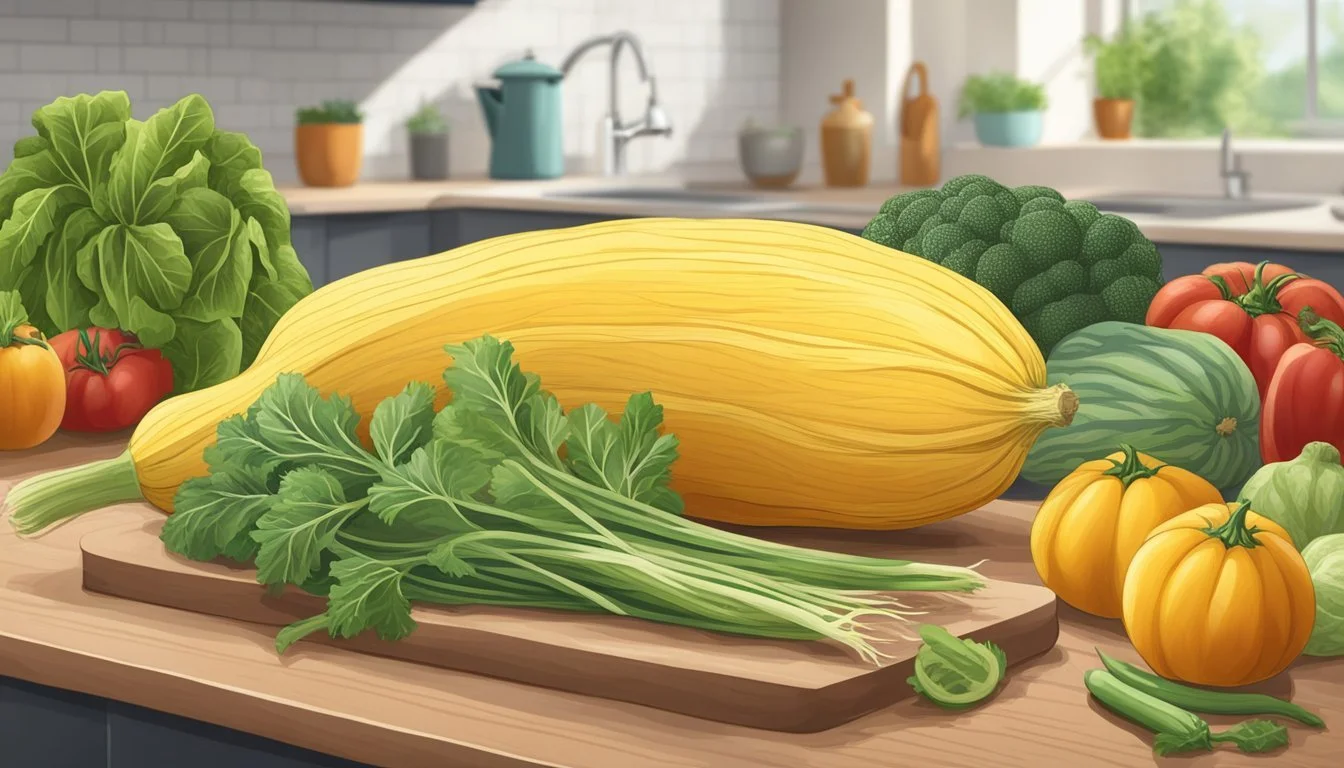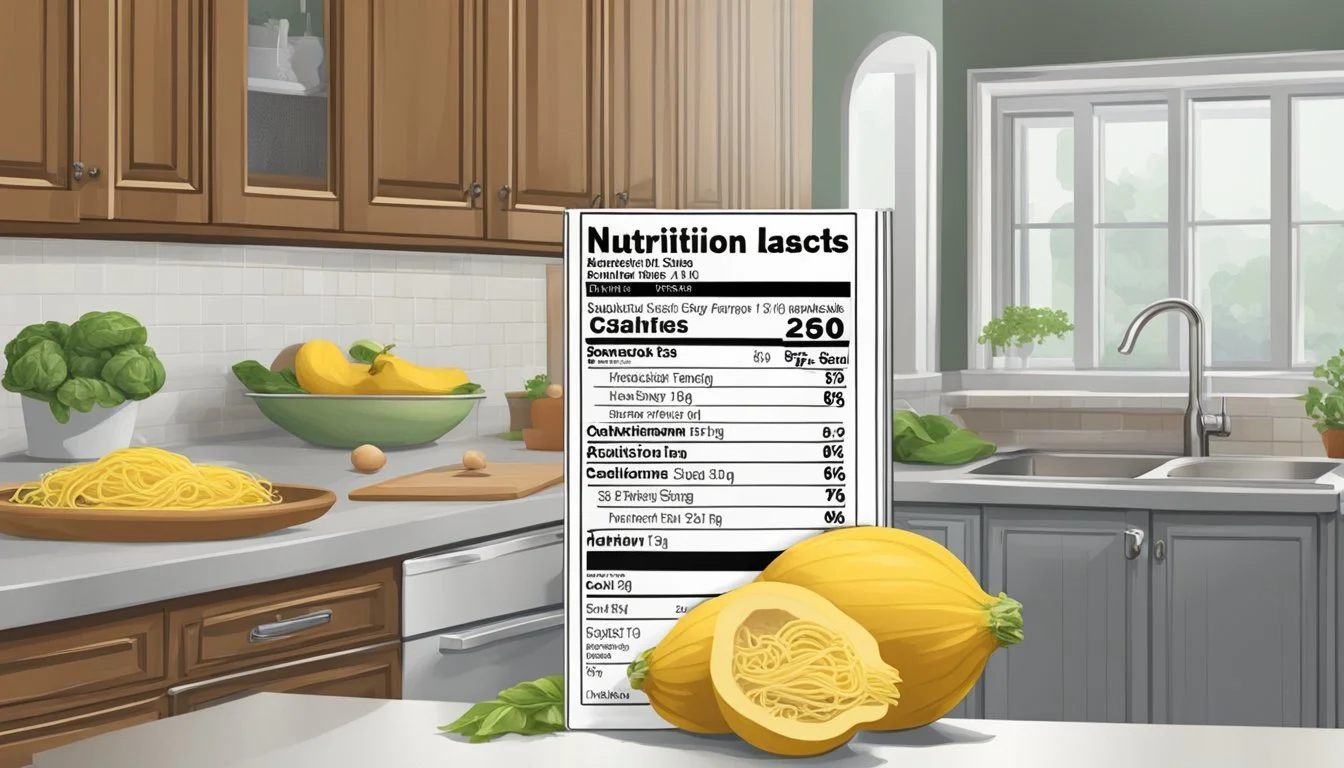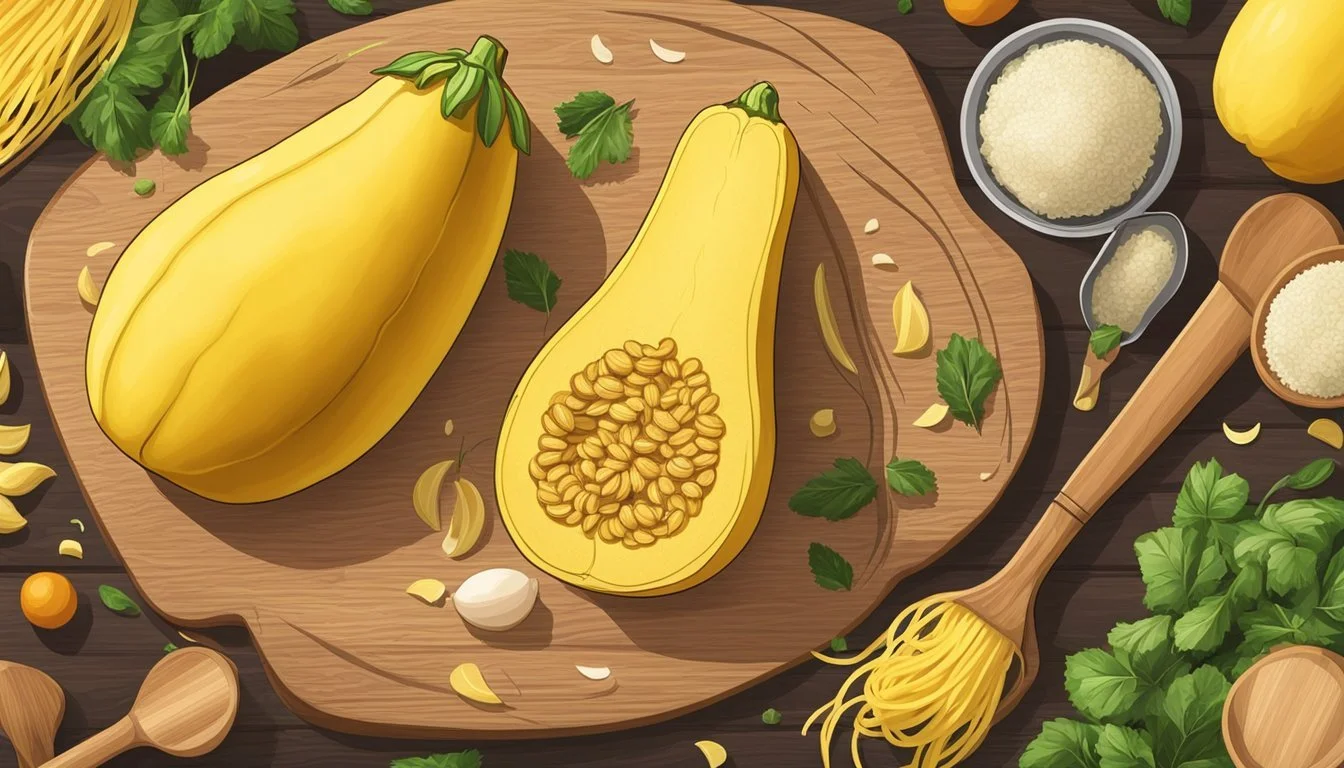Does Spaghetti Squash Go Bad?
Understanding Its Shelf Life and Spoilage Signs
Spaghetti squash is a nutritious vegetable known for its stringy, pasta-like flesh that separates into strands resembling spaghetti when cooked. As a versatile food, it's often used as a low-carb alternative to traditional pasta and is heralded for its ample vitamins, minerals, and dietary fiber. However, like all fresh produce, spaghetti squash has a finite shelf life and can go bad.
To extend its longevity, proper storage is key. A whole, uncut spaghetti squash can last about a month when kept in a cool, dark place. Once cut or cooked, the shelf life decreases, and it should be stored in the refrigerator. In the fridge, cut squash remains good for 5 to 7 days, while cooked squash should be consumed within 3 to 4 days to ensure quality and safety.
Determining whether spaghetti squash has gone bad involves checking for certain tell-tale signs. These include a softening rind, a foul odor, dark or discolored spots, and a mushy texture of the flesh. If any of these signs are present, it is best to discard the squash to avoid the risks associated with spoiled food.
Identifying Fresh Spaghetti Squash
When shopping for spaghetti squash, indicators of ripeness and quality can ensure one picks a squash that will have the best texture and flavor when cooked.
Signs of a Ripe Spaghetti Squash
A ripe spaghetti squash possesses certain characteristics that make it easy to identify. One should observe the following features:
Color: A ripe spaghetti squash will display a vibrant yellow or golden color. It should be uniform without any large green patches, which suggest immaturity.
Heavy for Its Size: The squash should feel relatively heavy when lifted, indicating a dense flesh inside.
Thick Rind: Pressing on the squash should reveal a hard, thick skin. While a slight give indicates ripeness, the rind should not feel soft or mushy.
Stem: The presence of a dry, brown stem indicates that the squash has been properly cured, which is a sign of ripeness.
Selection at the Grocery Store
When one is at the grocery store, a few additional considerations will help in selecting a quality spaghetti squash:
Examine the Appearance: Avoid any spaghetti squash that has dark or discolored spots as this may be an indication of spoilage.
Check for Damage: Inspect the squash for any blemishes, soft spots, or bruises. These are signs of damage and decay, compromising the squash's longevity and flavor.
Thick Skin: Ensure that the rind is uniformly hard. A thick skin serves as a protective barrier and indicates a lower risk of premature spoilage.
By observing these attributes, one can confidently pick a fresh, ripe spaghetti squash that is ready for culinary use.
Storing Spaghetti Squash
Proper storage of spaghetti squash extends its shelf life and preserves its quality. The key factors to consider are the storage location, temperature, and whether the squash is whole or cut.
Short-Term Storage
Fresh Spaghetti Squash: To maintain freshness, whole, uncut spaghetti squash should be stored in a cool, dry place, such as a pantry. The ideal temperature range is between 50°F (10°C) and 60°F (15°C). In this environment, the squash can last about a month.
Cooked Spaghetti Squash: Leftovers should be kept in an airtight container in the refrigerator and are best consumed within 3 to 4 days to maintain flavor and texture.
Long-Term Storage
For longer shelf life, whole spaghetti squash can be kept at a consistent temperature between 50°F (10°C) and 60°F (15°C), avoiding any locations above 70°F (21°C), as higher temperatures can expedite spoilage. Properly stored, the squash can last from 1 to 3 months. The flesh should remain firm, and the skin should be free of blemishes or soft spots to ensure it lasts as long as possible.
Freezing Spaghetti Squash
To freeze cooked spaghetti squash, one should wait for it to cool, and then portion it into an airtight container or a freezer bag, ensuring proper sealing to prevent freezer burn. Frozen cooked spaghetti squash can last several months.
Freezing raw spaghetti squash is not recommended, as it can alter the texture and moisture content of the flesh. If one opts to freeze raw spaghetti squash, they should be prepared for potential changes in quality once thawed.
Signs of Spoilage
When assessing whether spaghetti squash has gone bad, one should look for visual changes, smell the squash for any off odors, and feel the texture to ensure it hasn't softened beyond what's typical for cooked squash.
Visual Indicators
Spaghetti squash begins to show signs of spoilage through certain visual cues. These include:
Discoloration: The presence of dark, black, or browning spots can indicate mold growth or rot.
White fuzz: Mold may appear as a white, fuzzy substance on the skin or the flesh of the squash.
Hollow sections: Portions of the squash may appear to have collapsed or become hollow.
Olfactory Cues
A spaghetti squash's smell is a potent indicator of its condition:
Foul odor: Any rancid or unpleasant smells emitting from the squash typically signal that it is no longer edible.
Texture and Firmness
The texture of spaghetti squash is another critical factor in determining its edibility:
Soft spots: Soft or mushy areas on the squash may suggest internal spoilage.
Mushy texture: If the flesh feels moist, soft, and lacks the firmness of fresh squash, it is likely past its prime.
Cooked squash: Once cooked, spaghetti squash should retain a certain firmness. Spoilage can result in a slushy, overly soft consistency.
Handling Spoiled Squash
When spaghetti squash goes bad, it poses certain health risks. It is vital to recognize the signs of spoilage and understand the necessary actions to prevent foodborne illnesses.
Health Implications
Spoiled spaghetti squash may lead to food poisoning if consumed. Foodborne illnesses can occur when squash decays and harbors harmful bacteria. Signs of spoilage include a foul odor, changes in texture to a soft or mushy consistency, and the presence of mold. If any of these signs are evident, the squash should be discarded immediately to prevent health risks. It is critical to handle decaying produce with care, ensuring it does not contaminate other food items.
Cooking with Spaghetti Squash
Spaghetti squash is a versatile and healthy alternative to traditional pasta. It's a low-calorie, nutritious vegetable that can be cooked in a variety of ways to suit any palate.
Preparation Techniques
Before cooking, spaghetti squash should be washed and cut. To cut the squash, use a sharp knife and slice in half lengthwise. Remove the seeds and stringy bits from the center. The flesh should be a bright, even color, indicating that the squash is ripe and ready to be cooked.
Cooking Methods
There are several methods for cooking spaghetti squash:
Baking: Place the squash halves cut-side down on a baking sheet and bake at 400°F until fork-tender.
Microwaving: Place cut-up squash with a bit of water in a microwave-safe dish, cover, and cook on high until soft.
Steaming: In a pot with a steamer basket, steam the halves or cut-up squash until tender.
Each of these methods preserves the squash's delicate, stringy texture.
Recipes and Serving Suggestions
Once cooked, spaghetti squash can be enjoyed in various ways:
Toss with garlic, olive oil, and parmesan for a simple dish.
Use it as a base for meat or vegetable sauces.
Incorporate into soups or salads for added texture and taste.
The squash's subtle flavor pairs well with a multitude of ingredients from the grocery store.
Storing Cooked Squash
Leftovers should be stored properly to maintain their quality:
Room Temperature: Not recommended for storing cooked squash.
Refrigerator: Store in an airtight container for 3-4 days.
Freezer: For longer storage, freeze in covered airtight containers or heavy-duty freezer bags.
When reheating, ensure the squash maintains its texture without becoming mushy.
Nutritional Information
Spaghetti squash is a nutritious option low in calories and rich in certain vitamins and minerals, making it a health-conscious choice for those monitoring their diet.
Macronutrients and Calories
Spaghetti squash contains 42 calories per cup (approximately 155 grams when cooked), which is significantly lower than traditional pasta. It is an ideal low-calorie and low-carb alternative with the following macronutrient profile:
Carbohydrates: 10 grams
Dietary Fiber: 2.2 grams
Protein: 1 gram
Fat: 0.4 grams
This composition makes it an attractive option for maintaining a balanced diet.
Vitamins and Minerals Content
Nutritionally, spaghetti squash boasts a variety of vitamins and minerals. It is a good source of vitamin A, which plays a role in vision, immune function, and cell growth. Spaghetti squash also provides vitamin C, integral for collagen production, iron absorption, and immune defense.
Here is a more detailed breakdown:
Vitamin A: Prominent in cooked spaghetti squash, supports eye health.
Vitamin C: Offers antioxidant properties and aids in tissue repair.
B Vitamins: Includes B6 and others important for energy metabolism.
Manganese: A mineral that supports bone health and metabolism.
Additionally, spaghetti squash contains potassium, which helps regulate blood pressure and is integral for heart function. Trace amounts of iron and other minerals are also present, contributing to overall health. The presence of antioxidants adds to its nutritional value, safeguarding the body from oxidative stress.
Alternative Spaghetti Squash Options
When considering the preservation of spaghetti squash, one may look into alternative storage options beyond the typical refrigerator or pantry. Freezing spaghetti squash is a viable option that extends its shelf life significantly. Before freezing, one should cook the squash, then remove the flesh with a fork to create vegetable spaghetti strands.
To Freeze Cooked Spaghetti Squash:
Let the cooked squash cool completely.
Use a fork to shred the squash into noodles.
Portion the noodle squash into freezer-safe bags or containers.
Label with the date and freeze.
Frozen spaghetti squash can maintain its quality for up to 8 months, making it a healthy and versatile component for future meals.
Beyond storage, consumers might explore other squash varieties as substitutes for spaghetti squash. Alternatives such as butternut squash or acorn squash can be prepared in a similar fashion but will have a different texture and taste profile. These can be spiralized or cut into ribbons for a different take on vegetable noodles.
Alternative Squash Options:
Butternut Squash: Creamier and sweeter, suitable for both sweet and savory dishes.
Acorn Squash: Has a firmer texture, good for stuffing and baking.
Zucchini: Another popular noodle alternative, which can be used raw or cooked.
In summary, spaghetti squash is not the only option for those seeking a nutritious and freezer-friendly alternative to pasta. Other squashes can offer diversity in flavor and nutrition while retaining the health benefits of a vegetable-based noodle option.
Environmental Impact
When discussing the environmental impact of spaghetti squash, one must consider both the cultivation methods and storage techniques. These factors directly relate to the sustainability of the squash and its carbon footprint.
Sustainable Farming and Storage Practices
Sustainable Farming: Farmers who adopt sustainable cultivation practices for spaghetti squash can minimize environmental damage. This includes using fewer pesticides, practicing crop rotation, and controlling water usage. These methods help maintain soil health and biodiversity, leading to a reduced ecological footprint.
Storage Practices: How spaghetti squash is stored impacts its longevity and, by extension, the environment. When stored properly in a cool, dry place away from direct sunlight, the squash can last longer, thus reducing food waste. To conserve its quality, avoiding the use of plastic wrap is advisable as it can encourage spoilage. Instead, environmentally friendly alternatives like beeswax wraps can be used, promoting both fruit longevity and waste reduction.









